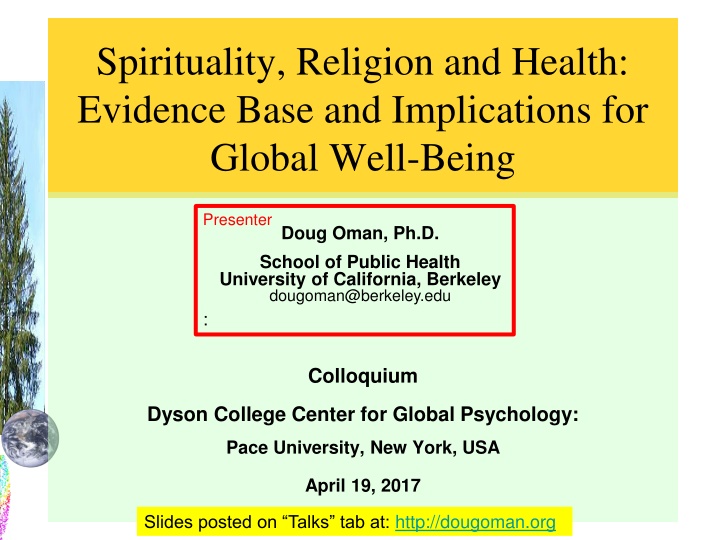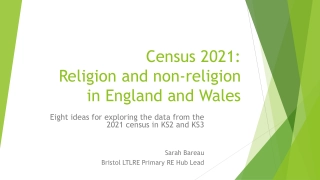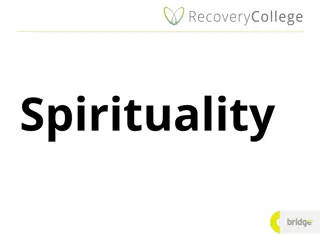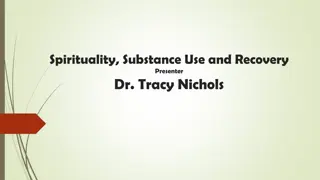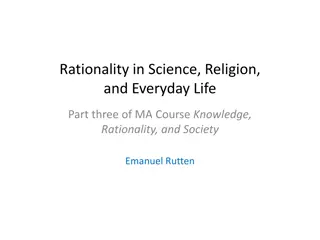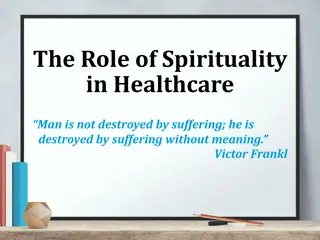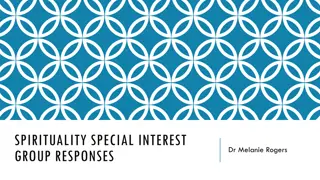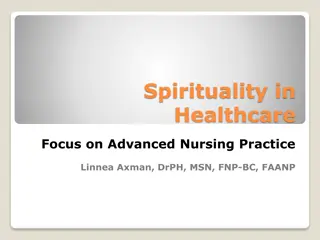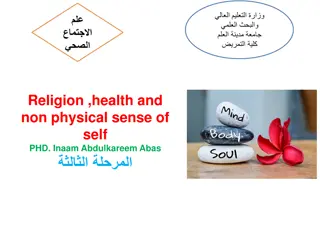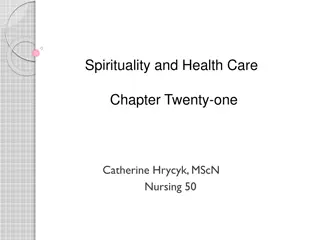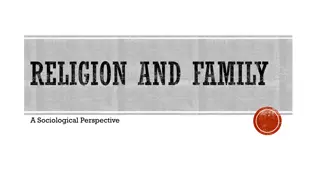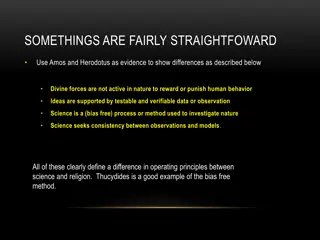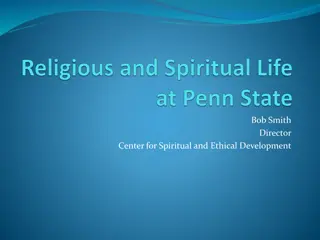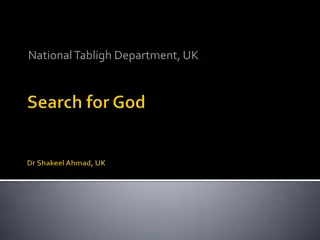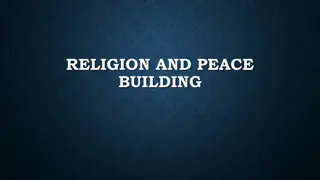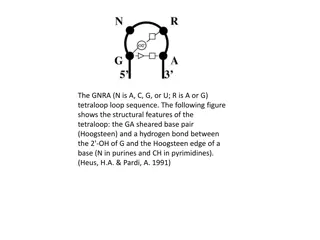Spirituality, Religion, and Health: Evidence Base and Implications
This presentation by Doug Oman, Ph.D., explores the close connection between spirituality, religion, and health, highlighting the rise, fall, and resurgence of interest in this area. It delves into the cross-cultural perspectives, implications for health and education, and policy considerations, emphasizing the empirical evidence supporting the positive impact of religion and spirituality on well-being. Through an analysis of major findings, the talk underscores the importance of understanding the role of spirituality and religion in promoting global health and overall well-being.
Download Presentation

Please find below an Image/Link to download the presentation.
The content on the website is provided AS IS for your information and personal use only. It may not be sold, licensed, or shared on other websites without obtaining consent from the author.If you encounter any issues during the download, it is possible that the publisher has removed the file from their server.
You are allowed to download the files provided on this website for personal or commercial use, subject to the condition that they are used lawfully. All files are the property of their respective owners.
The content on the website is provided AS IS for your information and personal use only. It may not be sold, licensed, or shared on other websites without obtaining consent from the author.
E N D
Presentation Transcript
Spirituality, Religion and Health: Evidence Base and Implications for Global Well-Being Presenter Doug Oman, Ph.D. School of Public Health University of California, Berkeley dougoman@berkeley.edu : Colloquium Dyson College Center for Global Psychology: Pace University, New York, USA April 19, 2017 Slides posted on Talks tab at: http://dougoman.org
Todays Talk OUTLINE Theme 1. Why Religion and Spirituality? Why Now? as factors in well-being 2. Cross-cultural Perspectives 3. Implications: Practice in Health, Education 4. Policy + Conclusions 2
1. Religion/Spirituality and Health: A Close Connection? Health and Holy : Both derived from Old English root hal, meaning entire or complete * (Marks, 2012) 3 *and from Proto Indo-European *kailo- whole, uninjured, of good omen
1. Rise, Fall, & Rise of R/S in Psychology 1902 William James: Varieties of Religious Experience Universal approach, Healthy + unhealthy 1907 Freud denigrated religion as a universal obsessional neurosis 1913- Behaviorism & decline of interest in R/S 20+ APA-published books on R/S 2-volume APA Handbook on R/S vol. 2 is Applied Science 2017 2009- 2 APA-published journals on R/S 4 2013 (2 vol.) 2014-
What Happened? Unlike Freud, people examined Empirical evidence 5
Increased Empirical Study of R/S-Health 1. R/S-health empirical literature: 1200+ studies in 20th century 2000+ additional studies from 2000 to 2009 118 systematic reviews (33 meta-analyses) WHY RELIGION & SPIRITUALITY MATTER FOR PUBLIC HEALTH: EVIDENCE, IMPLICATIONS, AND RESOURCES Koenig et al (2001). Handbook of Religion and Health. DOUG OMAN (ED.) Koenig et al (2012), Oxford University Press. Oman (2017), forthcoming (Springer) second edition (Oxford) 6
Rediscovery of R/S-Health: Major Findings 1. Religion and Spirituality (R/S) are mostly associated with better physical & mental health R/S (some dimensions) have at times been associated with worse health: Extreme R/S beliefs (e.g., refuse medical care) R/S struggles (persistent conflicts related to R/S) 7
Sample Findings: Health Outcomes from Meta-Analyses 1. Hummer &c (1999), N>20,000 +7 years US adults Heavy smoking (RH) +14 years African Americans Physical Health R/S (mostly western samples) longevity (18% less risk of death, HR=0.82, p <0.001) kMA=36 (Chida et al, 2009) lower rates of cardiovascular diseases, cancer, pulmonary disease, dementia, and disability (Koenig et al, 2012) Mental Health R/S less depression kMA=147 (Smith &c, 2003) R/S better mental health kMA=35 (Hackney &c, 2003) R/S-accommodative therapies outperform both no-treatment controls (d=.45) & alternate secular therapies (d=.26) (Worthington &c, 2011) 8
1. Pathways: How might R/S affect health? (what mechanisms ?) R/S Coping Physical Spirituality Spirituality & Religion & Religion R/S Meditation Health Mental Health / Character Strengths reduced stress ( allostatic load ) 9 Moderated by Sociocultural CONTEXT (Koenig, Larson & McCullough, 2001) (Oman & Thoresen, 2002, 2007)
Sample Findings: Pathways from Meta-Analyses Health Behaviors R/S less youth risk behavior kMA=75 (Yonker &c, 2012) R/S less youth substance abuse kMA=22 (Yeung &c, 2009) 1. Social Connections R/S marital stability kMA=94 (Mahoney &c, 2001) Religious/Spiritual Coping R/S coping better adjustment kMA=49 (Ano & Vasconcelles, 2005) 10
2. Many Empirical Studies are Based in USA So is there Cross-Cultural Corroboration? 11
Cross-Cultural Corroboration: Sites 2. Poland, Central America, Mexico, Iran, Israel, Lebanon, South Africa Australia, Finland, Hungary, Poland, Spain, United Kingdom, Brazil, the Caribbean, Central America, Mexico, Israel, Lebanon, Thailand, Turkey, South Africa Australia, Slovakia, the Caribbean, Iran, Israel, Kenya, Malawi, Nigeria Netherlands, Yugoslavia, Mexico, Iran, Israel, Palestine, Afghanistan, Taiwan Germany, Israel, Afghanistan, Japan, Sri Lanka R/S smoking*? R/S alcohol*? R/S risky sexual activity*? R/S depression*? R/S anxiety*? R/S adult well-being? R/S youth well-being? Uruguay, Kuwait, India, Malaysia, Pakistan, 140+ worldwide Australia, Ukraine, United Kingdom, India, Thailand, Cameroon Greece, Italy, Netherlands, United Kingdom, West Indies, Egypt, Israel, Kuwait, Turkey, India, Japan, Taiwan, Thailand, South Africa Bosnia, Denmark, Finland, Italy, Poland, Scotland, Caribbean, Latin America, Mexico, Israel, Taiwan R/S 12 hypertension*? R/S self-rated health? *reduced
Implications for Practice (Generic) 3. ___USA___ 1. Clinicians can proactively support and acknowledge R/S as coping resource Competencies (Vieten &c, 2016) APA books R/S accommodative Txs a. Mental healthcare b. Medical care Spiritual histories Structured protocols to talk (Kristeller &c, 2005) c. Accrediting Organizations (The Joint Commission JCAHO) Require capacity to assess R/S Require assessments on intake Focus + editors: UK, Australia, USA INTERNATIONAL Apply similar principles Oxford Textbook of Spirituality in Healthcare (Cobb &c, 2012) 13
Implications for Practice (Generic) 3. ___USA___ 2. Encourage or Teach Evidence-Supported R/S Practices (w/o endorsing R/S beliefs) Diverse methods + benefits (Oman, 2010; Sedlmeier &c, 2012) Spiritual added value possible (Wachholtz &c, 2008) a. Meditation (sitting) (both spiritual, secular) Supports/activates R/S coping Mental health benefits (Bormann &c, 2007, 2012) Portable usable with little leisure (poor) b. Mantram or holy name repetition ( portable ) at Veterans Administration INTERNATIONAL Similar Cross-culturally widespread Meditation in all major R/S traditions (Goleman, 1988; Plante, 2010) Ramanama 14 (health program for masses)
Implications: 3. Common Ground Strategy Support NOT require Proactively support coping that aligns: insights from professional expertise ( outsider or etic ) with spiritual traditions &/or perspectives ( insider or emic ) Common Ground Strategy Ethical respect for R/S diversity (+ agnostic, atheist) 15
4. More Applications: Globally and Locally? Apply common ground strategy across diverse sectors in society? Mental healthcare Medical care Public health Natural resource management Education Etc. 16
Common Ground Approaches 4. 1. Public health a. Task: Promote health of populations b. R/S functions: Ignore Passive conduit Active partner International Agencies IATF-FBO UN Inter-Agency Task Force on Engaging FBOs for Development PaRD International Partnership on Religion and Sustainable Development JLIFLC Joint Learning Initiative on Faith and Local Communities [http://jliflc.com] Campbell &c (2007) USA: cultural tailoring (surface, deep) South Africa: religious health assets Cochrane Schmid, & Cutts (2011) When Religion and Health Align 17
Common Ground Approaches 4. 2. Education Teach R/S-derived practices that foster well-being? Meditation &/or mindfulness? USA Contemplative Pedagogy (Simmer Brown &c, 2011) Strengths + weaknesses Superficial? Bleaches out spiritual and triggers/links to R/S coping (not common ground?)? 18
Issue #2 One Meditation Size Doesn t Fit All Over 7 years, Burke (2012) taught four modes of meditation to students (n=247) in rotating order: Only 31.6% preferred Mindfulness Method Mantra First choice (%) 31.6 Many methods have specific ways of tying meditation to R/S cognitions and access to R/S modes of coping Mindfulness Qigong Zen 31.6 22.0 14.8 19
Common Ground Approaches 4. 2. Education Teach R/S-derived practices that foster well-being? Meditation &/or mindfulness? USA Contemplative Pedagogy (Simmer Brown &c, 2011) Strengths + weaknesses Superficial? Bleaches out spiritual and triggers/links to R/S coping (not common ground?)? Indian Psychology Movement (2002-) Recover indigenous psychologies Indian model curricula (2016) Flexibly teach contemplative practices Paranjpe &c (2016) report Prototype for other nonwestern countries? 20
4. Middle Path Challenge: Healthcare + Education How balance pluralism + depth? What role for meditation / mindfulness in healthcare + education? Different people prefer different methods (Burke, 2012) Three approaches, each flawed 1. Teach single method in-depth (e.g., TM or MBSR) 2. Sampler method-of-the-week 3. Outsource to community diversity + community expertise (Sarath, 2003) Perhaps only solvable at level of institution, not level of class? (Oman, 2016) 21
Summary Enormous empirical base on R/S-well-being cross-cultural corroboration Strategy: Build on common ground ideally evidence-supported in diverse sectors: Mental healthcare Medical care Public health Natural resource management Education Etc. THANK YOU 22 Slides posted on Talks tab at: http://dougoman.org
